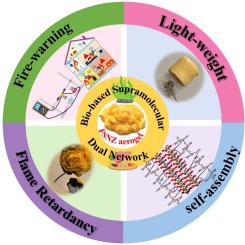Zn2+诱导层次化全生物基超分子叶酸盐/海藻酸盐双网络,形成超轻、防火的气凝胶
IF 7.4
2区 化学
Q1 POLYMER SCIENCE
引用次数: 0
摘要
基于超分子自组装的气凝胶已成为气凝胶研究的热点之一。在这里,我们报道了一个全生物基的分层超分子气凝胶,具有低密度,优异的阻燃和火灾报警反应,通过叶酸四聚体(fa -四聚体)和海藻酸钠的简单超分子自组装。制备的FSNZ气凝胶密度为14.4 ~ 17.8 mg/cm3,导热系数低至33.6 mW/(m∙K)。制备的气凝胶具有良好的阻燃性和早期火灾报警能力(反应时间在3 s内),热释放值和烟释放值分别降低53.6%和82.3%。FSNZ气凝胶的阻燃机理归因于锌催化fa -四聚体和海藻酸盐的碳化作用,而火灾预警机理是基于氧化锌和石墨渣炭协同作用产生的温度响应半导体特性。因此,本研究的超分子FSNZ气凝胶为阻燃气凝胶的制备提供了一种新的策略。本文章由计算机程序翻译,如有差异,请以英文原文为准。

Zn2+ induced hierarchical all bio-based supramolecular folate/alginate dual network leading to ultra-light and fire-safety aerogels
Aerogels based on supramolecular self-assembly have become one of the hotspots in aerogel research. Herein, we reported a full biobased hierarchical supramolecular aerogel with low density, excellent flame retardant and fire-warning response which was obtained via a simple supramolecular self-assembly of folic acid tetramer (FA-tetramer) and sodium alginate. The density of the resultant FSNZ aerogels was ultralow at 14.4∼17.8 mg/cm3, and the thermal conductivity reaches as low as 33.6 mW/(m∙K). Moreover, the resultant aerogel showed an excellent flame-retardancy and early fire warning capability (responses within 3 s), The heat and smoke release value were reduced by 53.6 % and 82.3 %, respectively. The flame-retardant mechanism of FSNZ aerogels is attributed to the zinc-catalyzed carbonization of FA-tetramer and alginate, while the fire early-warning mechanism is based on the temperature-responsive semiconducting properties resulting from the synergistic effect of zinc oxide and graphitic residue char. As a result, the supramolecular FSNZ aerogels in this work provide a novel strategy for the preparation of flame-retardant aerogels.
求助全文
通过发布文献求助,成功后即可免费获取论文全文。
去求助
来源期刊

Polymer Degradation and Stability
化学-高分子科学
CiteScore
10.10
自引率
10.20%
发文量
325
审稿时长
23 days
期刊介绍:
Polymer Degradation and Stability deals with the degradation reactions and their control which are a major preoccupation of practitioners of the many and diverse aspects of modern polymer technology.
Deteriorative reactions occur during processing, when polymers are subjected to heat, oxygen and mechanical stress, and during the useful life of the materials when oxygen and sunlight are the most important degradative agencies. In more specialised applications, degradation may be induced by high energy radiation, ozone, atmospheric pollutants, mechanical stress, biological action, hydrolysis and many other influences. The mechanisms of these reactions and stabilisation processes must be understood if the technology and application of polymers are to continue to advance. The reporting of investigations of this kind is therefore a major function of this journal.
However there are also new developments in polymer technology in which degradation processes find positive applications. For example, photodegradable plastics are now available, the recycling of polymeric products will become increasingly important, degradation and combustion studies are involved in the definition of the fire hazards which are associated with polymeric materials and the microelectronics industry is vitally dependent upon polymer degradation in the manufacture of its circuitry. Polymer properties may also be improved by processes like curing and grafting, the chemistry of which can be closely related to that which causes physical deterioration in other circumstances.
 求助内容:
求助内容: 应助结果提醒方式:
应助结果提醒方式:


